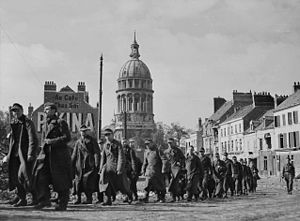Operation Wellhit
| Operation Wellhit (Battle of Boulogne) | |||||||
|---|---|---|---|---|---|---|---|
| Part of Western Front, World War II | |||||||
 German prisoners marching through Boulogne shortly after its capture, September 22, 1944 |
|||||||
|
|||||||
| Belligerents | |||||||
|
|
|
||||||
| Commanders and leaders | |||||||
|
|
|
||||||
| Strength | |||||||
| 2 infantry brigades with supporting armour, artillery and aircraft | 10,000 | ||||||
| Casualties and losses | |||||||
| 600 | ~500 (9,500 taken prisoner) | ||||||
Operation Wellhit was the World War II operation by the 3rd Canadian Division (Canadian 1st Army) to take the fortified port of Boulogne in northern France. At first, the 9th Canadian Infantry Brigade had hoped to take Boulogne as part of its advance up the coast. The defences, however, brought them to a halt five miles from the city.
Although the city's defences were incomplete, those that did exist were sufficiently formidable to justify massive bombardments before and during the assault and extensive use of specialised armour from the 79th Armoured Division. Despite the lower than expected level of material damage by the bombardments, the high degree of coordination between artillery, air force, armour and infantry greatly aided the success of the operation. The operation took from 17 to 22 September 1944.
Boulogne was one of several Channel ports to be designated as a "fortress" by Adolf Hitler. The idea was that these would be heavily fortified towns manned by troops committed to fight to the end, thus denying the allies the use of the facilities and committing allied troops at least to a containment role. In practice, Boulogne's landward defences were incomplete, many of its garrison troops were second-rate and demoralised by their isolation and the obvious inability of the Wehrmacht to rescue or support them. In the event, none of the strongpoints fought to the end, preferring to surrender when confronted by powerful forces. Their commander, Ferdinand Heim's own appreciation of the situation was realistic.
The city and port of Boulogne is sited at the mouth of the River Liane, which flows north, north westwards into the sea, which is to the north-west of the centre. The Liane splits the urban area, with the western side forming a high (250 feet high) peninsula between the river and the coast. High ground surrounds the city, with prominent heights, which had been fortified over the centuries. The most significant fortifications and artillery batteries were at La Tresorerie (inland from Wimereux and three miles north of the centre), at Mont Lambert (two miles east of the city centre), Herquelingue (2½ miles south-east of the city) and various fortifications south of Outreau on the "peninsula".
...
Wikipedia
